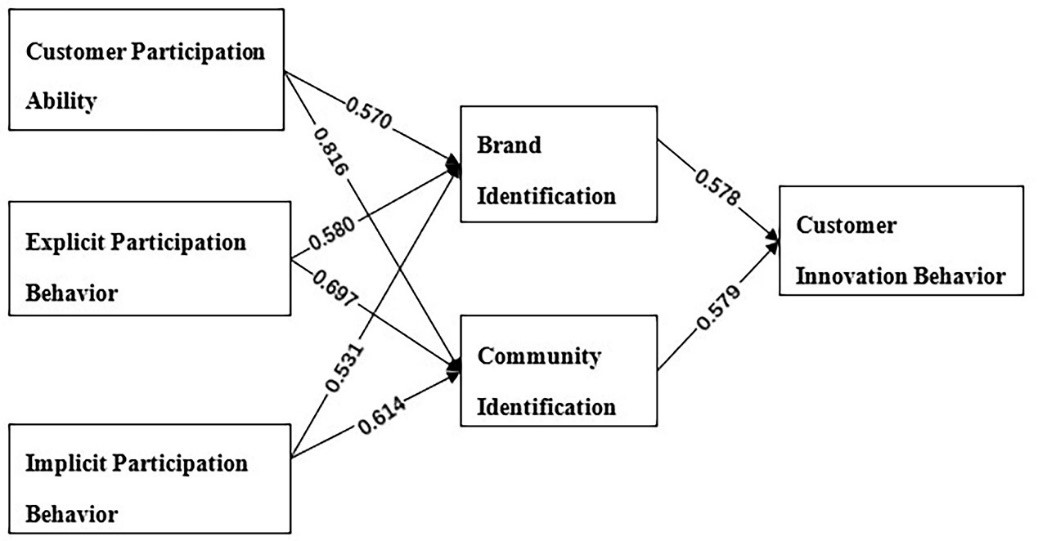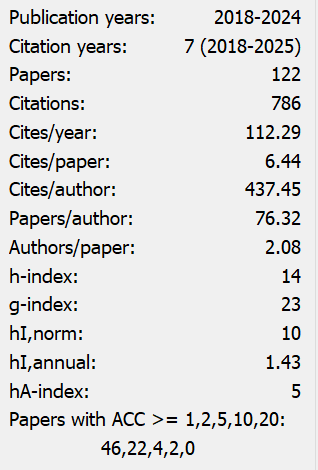Investigating the Impact of Customer Engagement on Customer Innovation Behaviors in Online Brand Communities
Abstract
In today's increasingly prosperous Internet economy, online brand communities are playing an increasingly important role in marketing. This paper starts with customer participation and studies its relationship with customer innovation behavior. Existing research shows that customers' sense of identity with brand community will make them have more innovative behaviors. Therefore, this paper explores the mediating role of identity (brand identity and community identity) in the relationship between customer participation and customer innovation. The research results show that customer participation has a positive impact on customer innovation behavior, brand identity and community identity have a positive impact on customer innovation behavior, and brand identity and community identity play an intermediary role in customer participation and customer innovation behavior, that is, customer participation can generate more customer innovation behaviors by strengthening brand identity and community identity.
References
Bagozzi, R. P., & Dholakia, U. M. (2006). Antecedents and purchase consequences of customer participation in small group brand communities[J]. International Journal of Research in Marketing, 23, 45-61. https://doi.org/10.1016/j.ijresmar.2006.01.005
Bergami, M., & Bagozzi, R. P. (2000). Self-Categorization, Affective Commitment and Group Self-Esteem as Distinct Aspects of Social Identity in The Organization[J]. British Journal of Social Psychology, 39(4), 555-577. https://doi.org/10.1348/014466600164633.
Brugmann, J., Prahalad, C. K. (2007). Cocreating business’s new social compact[J]. Harvard Business Review, 85(2), 80-90, 156.
Carlson, B. D., Suter, T. A., Brown, T. J., (2008). Social versus psychological brand community :the role of psychological sense of brand community[J]. Journal of Business Research, 61(4), 284-291. https://doi.org/10.1016/j.jbusres.2007.06.022
Ennew, C. T., & Birks, M. R. (1999). Impact of Participative Service Relationships on Quality Satisfaction and Retention: An Exploratory Study[J]. Journal of Business Research, 121-132. https://doi.org/10.1016/S0148-2963(98)00016-2
Feng, J. Z., & Cai, S. Q. (2020). Matching customer identification model and case study in virtual brand communities[J]. Chinese Journal of Management, 17(9), 1364-1372.
Gao, F. (2021). Customer Participation, Customer-Enterprise Identity and Brand Attachment: The Moderating Role Based on Internet Word of Mouth [J]. Business Economics Research, (16), 77-80.
He, G. Z., & Chen, R. Q. (2009). Research on leading user identification methods in consumer goods industry[J]. Statistics & Decision, (4), 15-17.
Horstmeier, C. A. L., Homan, A. C., Rosenauer, D., & Voelpel, S. C. (2016). Developing Multiple Identifications through Different Social Interactions at Work[J]. European Journal of Work and Organizational Psychology, 6(6),928-944. https://doi.org/10.1080/1359432X.2016.1185099
Hu, B., Xiong, Y. B., & Wang, H. (2015). Symbolic meaning and emotional brand attachment of tourism destination brands -- from the perspective of symbolic interaction theory[J]. Business Management Journal, 37(3), 120-129. https://doi.org/10.19616/j.cnki.bmj.2015.03.014
Huang, M. X., Liao, J. Y., & Zhou, N. (2015). Can community experience enhance consumers’ brand loyalty - A Study on the role and impact mechanism of different experience components[J]. Nankai Business Review, (3), 151-160.
Huang, M. X., Pan, H. L., & Liao, J. Y. (2017). Brand communication in social media era: a review of brand community research[J]. Business Management Journal, 39(2), 195-208. https://doi.org/10.19616/j.cnki.bmj.2017.02.013
Huang, X. Z., & Peng, S. H. (2017). Development and test of customer engagement scale based on B2C scenarios[J]. Journal of Commercial Economics, (11), 81-84.
James, H., M., John, W. S., & Harold, F. K. B. (2002). Brand Community[J]. Journal of Marketing, 66(1), 38-54. Retrieved from https://www.jstor.org/stable/3203368.
Jeong, S. W., Ha, S., Lee, K. H. (2020). How to Measure Social Capital in an Online Brand Community? A Comparison of Three Social Capital Scales[J]. Journal of Business Research, 2020. https://doi.org/10.1016/j.jbusres.2020.07.051.
Kankanhalli, A., Ye, H. J., & Teo, H. H. (2015). Comparing Potential and Actual Innovators: An Empirical Study of Mobile Data Services Innovation[J]. MIS Quarterly, 39(3), 667-682. Retrieved from https://www.jstor.org/stable/26629625
Kozinets, R. V., Hemetsberger, A., & Schauh J. (2008). The Wisdom of Consumer Crowds:Collective Innovation in the Age of Networked Marketing[J]. Journal of Macromarketing, 28(4), 339-354. https://doi.org/10.1177/0276146708325382
Li, C. H., Bu, Q. J., & Cao, B. (2019). How can customers participate in value co-creation in virtual brand community to enhance brand relationship? - The mediating role of brand experience [J]. Business Research, (06), 9-17. https://doi.org/10.13902/j.cnki .syyj.2019.06.002
Li, J., Zhang, X. S., & Li, X. G. (2020). The Influence Mechanism of Customer Engagement Style on Enterprise Brand Equity - Based on the Perspective of Relationship Connection[J]. China Circulation Economy, 34(03), 114-126. https://doi.org/10.14089/j.cnki .cn11-3664/f.2020.03.012.
Li, Q., Weng, Z. G., & Gao, D. H. (2021). Customer engagement ability identification: meaning, methods and strategies[J]. Foreign Economics and Management, 43(6), 27-42. https://doi.org/10.16538/j.cnki.fem.20210306.301
Lin, X., & Leung, K. (2014). What Signals does Procedural Justice Climate Convey? The Roles of Group Status,and Organizational Benevolence and Integrity[J].Journal of Organizational Behavior, 35(4), 464-488. https://doi.org/10.1002/job.1899.
Madupu, V., & Cooley, D. O. (2010). Antecedents and consequences of online brand community participation :a conceptual framework [J]. Journal of Internet Commerce, 9(2), 127-147. https://doi.org/10.1080/15332861.2010.503850
Muniz, A. M., & O'guinn, T. C. (2001). Brand Community [J]. Journal of Consumer Research, 27(4), 412-432. Retrieved from https://www.jstor.org/stable/10.1086/319618
Piehler, R., King, C., Burmann, C., & Xiong, L. (2016). The Importance of Employee Brand Understanding,Brand Identification,and Brand Commitment in Realizing Brand Citizenship Behaviour[J]. European Journal of Marketing, 50(9/10), 1575-1601. https://doi.org/10.1108/EJM-11-2014-0725
Prahalad, C. K., & Ramaswamy, V. (2000). Co-opting customer competence[J]. Harvard Business Review, 78(1), 79-87. https://doi.org/10.1023/A:1008796822813
Preacher, K. J., & Hayes, A. F. (2008). Asymptotic and Resampling Strategies for Assessing and Comparing Indirect Effects in Multiple Mediator Models[J]. Behavior Research Methods, 40(3), 879-891. https://doi.org/10.3758/BRM.40.3.879
Rodi, A. R., & Kleine, S. S. (2000). Customer participation in services production and delivery[J]. California: Sage Publications, 111-126. https://doi.org/10.19030/jabr.v10i2.5942
Vargo, S. L., & Lusch, R. F. (2004). Evolving to a New Dominant Logic for Marketing[J]. Journal of Marketing, 68(1), 1-17. https://doi.org/10.1509/jmkg.68.1.1.24036.
Wang, J., & Wang, X. M. (2021). Experience and Migration: Concept and Measurement of Online Community and Brand Fit[J]. News and Communication Review, 74(6), 92-104. https://doi.org/10.14086/j.cnki.xwycbpl.2021.06 .008
Wang, W., & Meng, T. (2021). Customer Innovation Behavior in Brand Community: Effects of Centrality and Structure Hole [J]. Journal of Management Science, 34(3), 135-147.
Wang, X. C., Chen, R. Q., & Jiang, Y. (2014). Research on innovation activities and their antecedents and aftereffects in online brand communities[J]. Chinese Journal of Management, 11(4), 577-584.
Wang, Y. Y., Wang, H. J., & Wang, X. C. (2015). The impact of insider identity perception on employees’ innovative behavior - the role of self-efficacy of innovation and compliance with the authority[J]. Journal of Psychological Science, 38(4), 954-959. https://doi.org/10.16719/j.cnki.1671-6981.2015.04.027
Wu, W. Z., & Cehn, Q. J. (2017). The impact of customer engagement behavior on customer satisfaction and behavior intention from the perspective of value co-creation[J]. Management Review, 29(9), 167-180. https://doi.org/10.14120/j.cnki.cn11-5057/f.2017.09.015
Xin, B. L., Liu, L. L., & Wang, X. J. (2021). Research on the Influence of Customer Participation on Employee Service Innovation Behavior: The Mediating Effect of Information Sharing and the Moderating Effect of Absorptive Capacity[J]. Soft Science, 35(2), 109-115. https://doi.org/10.13956/j.ss.1001-8409.2021.02.18
Yin, J. P., & Wang, Z. P. (2020). The relationship between emotional marketing, brand identity and brand loyalty [J]. China Circulation Economy, 34(9), 109-118. https://doi.org/10.14089/j.cnki.cn11-3664/f.2020.09.010
Zhang, Y. R., & Zuo, B. (2006). Social identification theories and their development[J]. Advances in Psychological Science, (3), 475-480.
Zhao, J. B. (2018). Impact of online brand community interactive information on inactive customers’ purchase intention[J]. China Business and Market, (6), 71-82. https://doi.org/10.14089/j.cnki.cn11-3664/f.2018.06.008
Zhao, J. B., & Jing, F. J. (2016). Research on the impact of online brand community atmosphere on customer innovation behavior[J]. Journal of Management Science, 29(4), 125-138.


This work is licensed under a Creative Commons Attribution 4.0 International License.
Copyright for this article is retained by the author(s), with first publication rights granted to the journal.
This is an open-access article distributed under the terms and conditions of the Creative Commons Attribution license (http://creativecommons.org/licenses/by/4.0/).


























